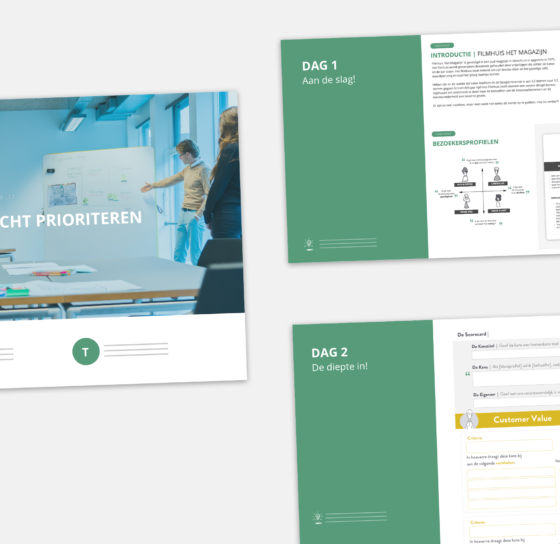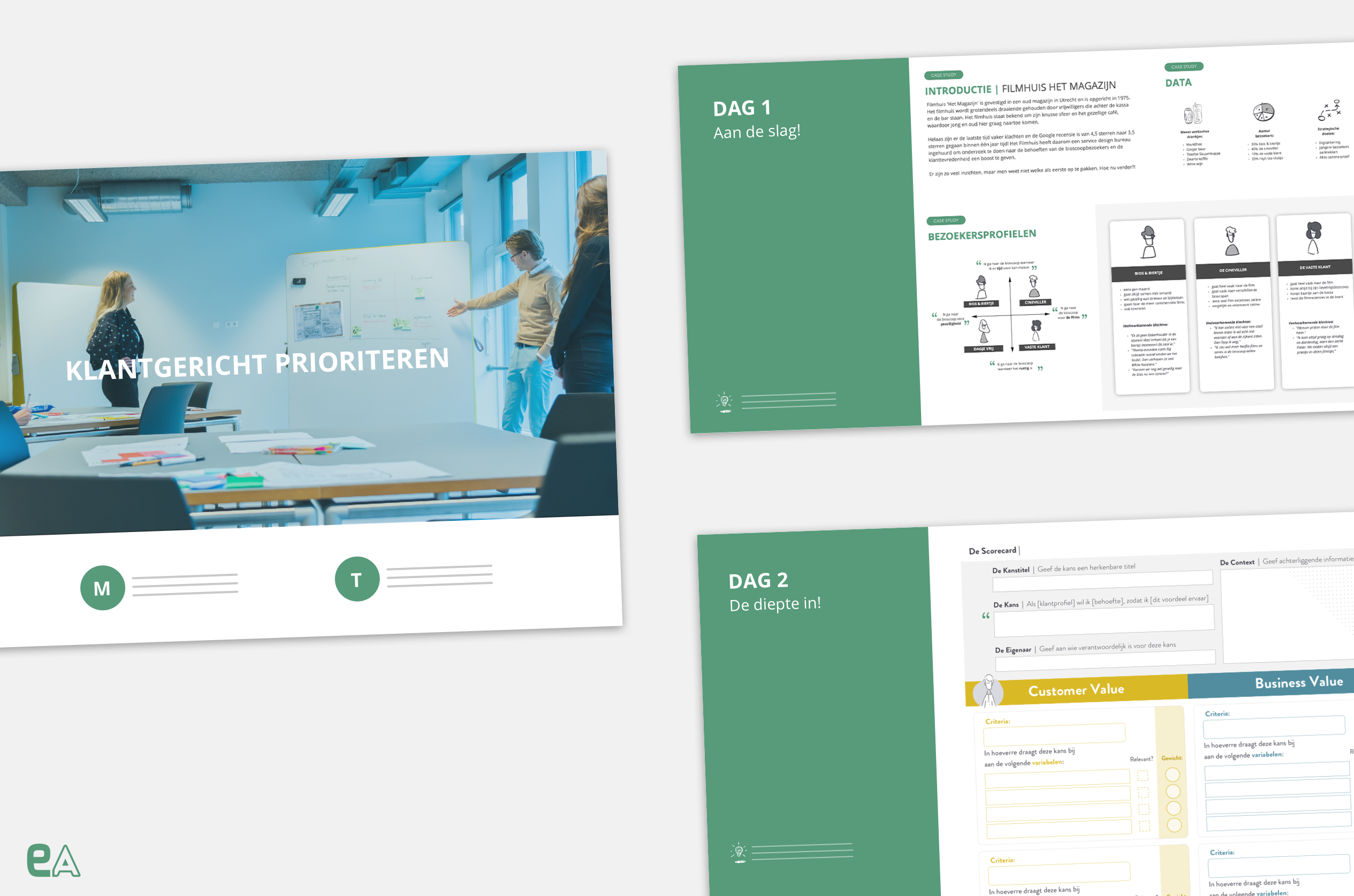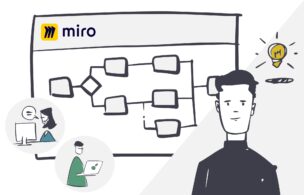Want to get some groceries quickly, or order them online? Bike through the rain, or take the public transport? An optimization in the check-out or designing a completely new landing page? In life or at work, we constantly make choices and weigh the pros and cons in our heads at a rapid pace, we prioritize. Making these choices is therefore often unconscious, not thought through and incomplete. Perhaps most importantly, it is subjective.
When a choice has to be made in a business context, it is therefore almost impossible to objectively capture all possible factors. Arguments are put forward and rationalized from one’s own frame of reference and priorities are set from there. The trick is to make this negotiable and public. Only then can we actually prioritize in a customer-centric way.
Download our SCORECARD template
This scorecard template offers a concrete picture of how to use the scorecard in the process of customer-centric prioritization. The first step towards customer-centric decision-making has thus been taken.
Good luck!
start the internal dialogue
Customer-centric prioritization requires disciplines to sit down together to balance customer experience and organizational interests. The discussion is at least as valuable as the outcome itself.
But first of all, conducting the right discussion that leads to support is the ultimate result of customer-centric prioritization. Perhaps unnecessarily, but the purpose here is to gain insight into why you do not agree with each other. In other words, you don’t have to agree. As a specialist product owner, service or CX designer or adjacent specialisms, it is crucial to sit around the table for this. If you are on your way to the ultimate customer experience, you need to initiate this conversation within your organization. You start that dialogue together and it covers the entire organization so that ‘the voice of the customer’, as it were, also participates in the discussion. In addition to working from a holistic point of view, you protect the process from common pitfalls, such as:
- Prioritizing based on gut feeling and not making this negotiable
- Lack of documentation of arguments used and measurability
- Prioritize out of your own interest or department KPIs as the main interest
It is clear that customer-centric prioritization is not a solo activity, you do this together with stakeholders from the organization. Customer-centric prioritization therefore requires a collective understanding of goals and ambitions within the organization. Go to the specially developed scorecard for customer prioritization through the download form.
create mutual understanding
A discussion that is indirectly about the growth potential of your organization usually makes use of observations from multiple disciplines. Ultimately, it is also about the gut feeling, but how do you use that feeling to create an opportunity for the customer and the organization? Exactly this part is part of the training customer-centric prioritization from our Academy. In order to arrive at a collective understanding that leads to support, the discussion should raise certain questions.
With customer-centric prioritization you challenge each other, has everyone interpreted the opportunities in the same way? And aren’t we shooting something too quickly? Because in all too many organizations, priorities go down in the implementation phase. It is precisely in this discussion that you make an effort not to immediately think in terms of solution options and effort. You conduct an internal dialogue that deals with questions such as what impact does the organization want to make. But also what you are working towards. Crucial questions that essentially boil down to the search for common frameworks that lead to nurturing a customer-oriented vision and strategy. So that from now on people will no longer go for the ‘quick wins’, but rather the longer term.
successful prioritization
What does the next step look like then? The discovered opportunities can be described as action-oriented needs that are scored on customer value and business value. These value(s) each have their own criteria and variables with which the opportunities are valued. In this way you work towards influencing the customer experience in a customer-oriented manner. This also shows the core of why customer prioritization is a collaborative process. Thanks to customer-oriented prioritization, each department/silo with the relevant specialism can contribute its perspectives for improving the customer journey. This not only concerns the outcome of the process, but also the process itself. How you set this up has everything to do with determining frameworks, applying structure and transparency. In a nutshell, the customer-oriented prioritization methodology consists of the following steps:
- Collect insights and engage stakeholders
- Identify the opportunities
- Organise a prioritization session
- Use the scorecard
- Start the discussion with use of the scorecard
- Discuss and weigh the opportunities
‘Customer-centric prioritization includes a focus on your customer and, above all, an internal dialogue’
The process of customer prioritization therefore often has to do with your team and the joint determination of the opportunities that exist. You do this by translating customer insights that arise from data, but certainly also from customer contact moments by employees, after all, you cannot get closer to your customer.
score, discuss and prioritize
Due to our many years of experience, in which we have been able to help various organizations in customer-centric work, we see that the criteria for a good customer experience can often be formulated generically. A satisfied, or rather, happy customer is what matters in the end and reflects on the company’s results.
It is often the variables under the criteria that make it context specific. During customer prioritization you will learn what these criteria are and how to make the variable specific to your organization. We do this by making a scorecard. The scorecard is therefore a good means of discussion in which we bring together action-oriented customer needs, customer and business values (criteria and underlying variables). During a prioritizing session, the gut feeling comes up with a scorecard and you put this on paper, almost literally, by using the scorecard. Everyone fills in the scorecard for themselves so that it serves as a starting point for the discussion. By discussing the opportunities, weighing them based on customer value and business value, you arrive at the point of prioritizing. We cannot emphasize often enough that it is mainly about the joint discussion rather than the figures that result from it.
For this we use the SOM rule.
- Samen (together): you only prioritize customer-centric if you do this together
- Open: determine what you prioritize so that subjectivity can be discussed
- Mandate: determine who is responsible and who takes control
These three basic principles are leading in the entire process of customer prioritization and guarantee the process towards an excellent customer experience. At Essense we work on the basis of an omnichannel concept and this also applies to customer prioritisation. Understanding customer needs is essential when developing customer-centric services. You want to know as much as possible about the customer in order to improve the service as optimally as possible. Only then can you respond to it. The holistic approach continues in the way in which the excellent customer experience is developed.
This is a joint effort, the commitment goes further than just the CX teams and it is up to the marketing managers, service designers, UX designers, e-commerce managers or product owners to allow the ideas of customer-oriented prioritization to land within the organization. Essense Academy offers the customer-centric prioritization training in which you are trained to, among other things, focus on customer needs and opportunities, without obstacles in terms of solution and effort. After this training you ensure support within the organization by bringing together different disciplines in a structured way and also aiming for execution and making an impact.
Download Scorecard
Please add your details below and we’ll mail you our Scorecard template with tips and instructions.









